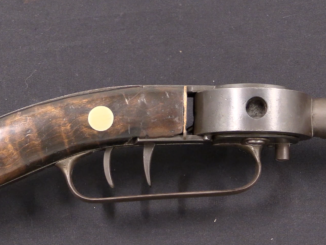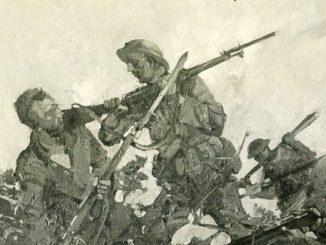This toggle-locking rifle chambered for the .30-06 cartridge is the second of two rifles submitted by White for the 1930 US military trials. It was not actually tested by the US, but White did take it to the UK where it was tested in the early 1930s. British officials liked that it was a positively locked action (unlike Pedersen’s toggle rifle, which was delayed blowback), but found it too fragile for combat use.
Related Articles

Antiques
Unique Rotating Single-Shot Percussion Rifle
This is a very unusual single-shot muzzleloading rifle. It is devoid of markings that might identify it, but appears (to my eye, anyway) to have been built from what was originally intended to be a […]

Forgotten History
Forgotten History: The Americans Take Blanc Mont Ridge, October 1918
The German army captured Blanc Mont Ridge in the early months of World War One and occupied it throughout the years of fighting, fending off repeated French assaults throughout 1915 and 1916. While the ridge […]

Book review
Book Review: Winchester Model 07 Self-Loading .351 Caliber
The full title of this recently-published monograph by Leonard Speckin is actually Winchester Model 07 Self-Loading .351 Caliber: Its Past and Its Future with Modern Brass, Bullets and Powders. There is very little modern published […]

How do you load it?
Is there some method of locking the action open, or do you hold it by hand as you jam a clip in there?
This is another indicator of Mr.White’s genius. The oddities in form of gumpy stock and skimpy barrel attachment could be easily eliminated. The front barrel attachment is particularly striking. On the other hand, bayonet attachment looks sound.
The action by itself is rather clever. I personally favour it because it involves mass of barrel in resistance against recoil force. Also, the benefit of no need for cleaning of gas cylinder/ piston is definite plus.
Personally, I have always been enamored and intrigued with toggle-lock operating systems and had always wondered why no one made an operational rifle action using one, at least until I found this group and the inimitable Ian. I particularly like the slide-action release that insures that the action will remain locked until after firing; simple but fool-proof. The design for the .30-06 cartridge gives it plenty of power for almost anything one might encounter, walking either on two or four legs, in the US. But now to another point if inquisitiveness about this type action; was there ever any attempts to produce a fully automatic weapon, either rifle or pistol, using the toggle action? I have always wondered if it would be possible to incorporate this with the inclined rearward bolt travel of the Jati in order to more effectively control muzzle climb in a machine pistol or short sub-machinegun. Just a thought ….
“toggle-lock”
Wait, I am bit confused with terminology, is Kniegelenkverschluss in German EXACTLY EQUAL to toogle-lock. If so then “fully automatic weapon” utilizing this principle were designed and mass-produced:
Furrer Lmg 25 – light machine gun employed by Swiss Army, fire 7.5×55 cartridge
W+F Lmg.-Pist 41/44 Furrer – sub-machine gun employed by Swiss Army, fire 9×19 cartridge (I don’t have any clue why it is not simply blow-back operated), see diagram here: http://world.guns.ru/smg/switch/w-f-lmg-pist-41-44-e.html
24 mm Tankbüchse 41 – AT rifle employed by Swiss Army
correction: Tankbüchse 41 is self-loading not fully automatic weapon
I was thinking about it too.
One hurdle apparently is that the toggle joint pops up vertically, where on modern rifles is the optical rail. This may be perhaps arranged sideways.
The current ‘normative’ rotating type of lock-up is much more compact, however.
“One hurdle apparently is that the toggle joint pops up vertically, where on modern rifles is the optical rail. This may be perhaps arranged sideways.”
If you require free space on top see Patent US3000268A:
https://www.google.com/patents/US3000268
Pretty much all of the early machine guns were toggle locked. Maxim, Vickers etc.
Well, toggle-locked machine guns have the advantage of not being swung around or bashed a lot. Rifles are less fortunate. The Maxim family was originally meant for static-defensive positions, not “break, bash, shoot and smash” operations up close and personal. It also was worth the money required to build and maintain it compared to the losses that its victims would suffer trying to put it out of action.
6 Maxim guns and supporting riflemen = thousands of dead tribal warriors during one battle, not one Brit killed. Toggle-locked pistols and rifles have the disadvantages of machining costs compared to their intended service specifications and a nasty tendency to get jammed in field conditions interfering with their toggles’ surface-friction properties!!!
Am I wrong on anything?
SAY SOMETHING!!!!!!!
It’s bayonet attachment isn’t sufficiently robust, the fuzzy wuzzys don’t like it up them you know they wiggle causing fatigue etc to the mechanism.
For many years, a man (woman) promoted to General was given a colt 32 acp pistol. In all those years, did anyone actually use this small pistol in a combat situation?
thank you
Here: http://www.coltautos.com/usgopistols/index.html is list of users Colt U.S. General Officers Pistols (both .32 and .380), I don’t read all entries but you can read about Colonel Carl Rueben Dutton that: “He only pulled (but didn’t shoot) his pistol once for defense. That was when he believed a Japanese spy was tailing him in the streets of Chungking.” Does you consider it to be “use this small pistol in a combat situation”?
yes, thank you.
That “gripping surface” on top of the bolt looks to be a cocking piece to me.
It’s understandable if you didn’t dry fire it to confirm though.
Mr Whites rifles, were bits of potential rifles, he never put together I think… There’s lot’s of good bits, here and there. But bits, are not appropriate for wartime adoption. However, wartime presented an opportunity to present bits, potential bits, which had potential. Technical achievement, in bits. Practical application in bits, bits. Very good, bits potentially.
The Garand, was the best option.
sir:
very interesting rifle, very robust toggle. i prefer the johnson & white recoil operation to that of the garand, and as between the johnson & white i like the johnson. and, btw, the johnson lives on in the ar-15 & 15 rifles, which are very similar to the johnson. you have only to look and think. btw, i have tried to determine how many u.s. soldiers were either wounded and/or killed by bayonets in wwii, and i can find no statistical data on the issue. to my mind, the entire bayonet thing is pretty much nonsense, given the paucity of actual combat involving bayonets. in wwi trench fighting i suspect the simple cudgel was used more than the bayonet.